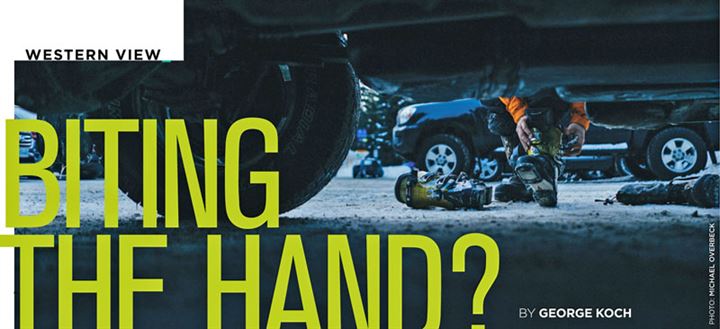by GEORGE KOCH in Winter 2018 issue
“Things are back to perfect now that most of the bloody tourists have effed off.”
The place was St. Anton, Austria. The time was near season’s end. The speaker? In this historically dirt-poor farming village that winter tourism had transformed into a magnet for famous and wealthy international skiers, the sentiment surely emanated from some wizened Tyrolean gnome too far into his plum brandy or other sub-species of indigent anti-socialite oblivious to tourism’s economic benefits. But no: the utterer was an Australian ski bum. Having travelled halfway around the globe to frolic in Austria’s winter-wonderland, he now considered himself a local, and with the coveted title, the right to be appalled at tourism’s blight on “his” village.
Last fall’s turmoil in Whistler surrounding “over-tourism” had me chuckling at these long-buried memories. Tourism, it seems, is great—as long as there aren’t too many actual tourists. Particularly of the wrong sort.
“We want to attract those people who enjoy and appreciate our community culture,” Whistler mayor Nancy Wilhelm-Morden told news media in October. Wilhelm-Morden was adding her voice to a rising chorus complaining about packed roads, overflowing public areas and stretched infrastructure. In a letter to a local newsmagazine, Bryce Leigh lamented how “the area surrounding the ‘Welcome to Whistler’ sign is perpetually covered in chip bags, pop bottles, beer cans, diapers, cigarette butts, human waste, and every other type of garbage.”
Mayor Wilhelm-Morden, a personal injury lawyer who was born and raised in Kitchener, Ontario, was especially pointed about day-trippers who clog up attractions favoured by locals, throw away food wrappers, beer bottles and even deflated tubes used to float down the famous River of Golden Dreams, and don’t appreciate Whistler’s “mountain culture.” And perhaps worst, don’t keep hotels full. “We have a significant machine that has to be fed,” she said, “and if people are driving up to Whistler for the day…that’s not going to sustain our economy, not by a long shot.” Whistler wants tourists who stay for “several days.”
The ungainly neologism “over-tourism” reflects an age-old tension. It often occurs in places whose culture and economy weren’t created by tourism but whose historical treasures or scenery are irresistible draws. Tourists begin as bemusing curiosities, grow into welcome economic boosts and eventually morph into irritating distractions and sometimes something darker: humiliating reminders that a once-dynamic destination has ossified into an open-air museum. Last summer, anti-tourism demonstrations rocked numerous European cities. The locals’ desire to maintain authenticity and self-respect can degenerate further, into a self-destructive hostility. Some Italian cities have graffiti welcoming illegal immigrants from Libya while telling paying tourists to go home.
Anti-tourism also erupts where tourism is the economic driver. The locals—genuine as well as arrivistes, and even seasoners like my Aussie buddy—come to resent those upon whom their livelihood and existence of the place they call home depend. Some feel entitled to a gleaming world-class infrastructure and comprehensive services along with virtually empty lifts, elbow room in shops and restaurants, and free parking. When nearly everyone is from somewhere else, those who stick around understandably wish to create a sense of rootedness. The finer the distinction between oneself and the tourist, the greater the need to create one.
Some places can take or leave tourism. Zurich’s health as an international financial centre doesn’t depend on foreigners paying $60 for a plate of Geschnetzteltes. But tourism has made Whistler. Year-round traffic approaches three-million visitations and spending of $1.5 billion. Without this money machine, the public officials who now pronounce upon various classes of tourist wouldn’t even have jobs. Not even 50 years ago Whistler was a tiny, shabby, no-hope logging town. The future site of Whistler Village was a garbage dump where frolicking bears furnished locals with some of their finer amusements. Perhaps Whistler’s leaders today could remind themselves of that past, or seek some perspective in contemplating the genuine despoliation of cultural gems by hordes of European youth enjoying drunken, public group sex.
I’m not unsympathetic to Whistler’s underlying sentiment. Over its long and at-times bumpy journey of growth and development, any successful resort can reach a stage where it feels like too much. It’s understandable that thoughtful locals will strive for a Goldilocks state—enough tourists to finance the best of everything, but not so many as to clog up the system and degrade the experience.
But town officials don’t get to pick and choose who comes. The implication that certain types of people and the money they bring aren’t good enough moves the conversation into the realm of social class and, in some European resorts I’ve visited, even race. The oft-forgotten fact remains that, in Whistler’s case, the Vancouver/Lower Mainland regional market provided the foundation of cash flow and reliable repeat traffic upon which the resort built its globe-girdling destination business model. To turn one’s back on the people who fuelled the entire enterprise would be as foolish as it is arrogant.




